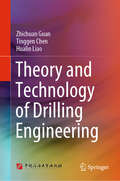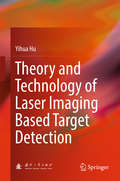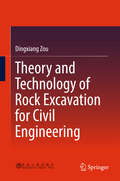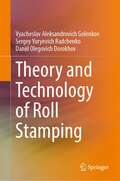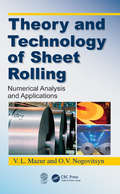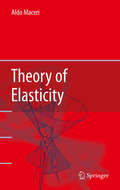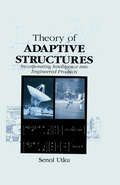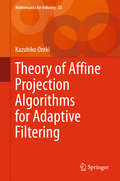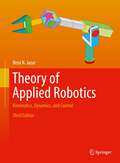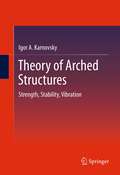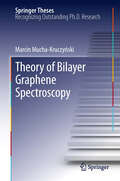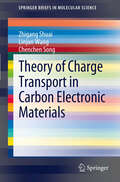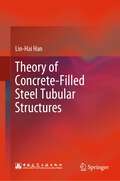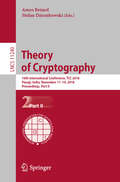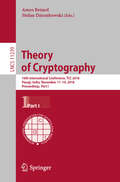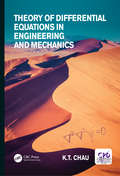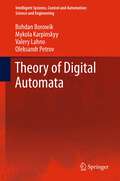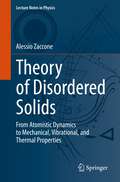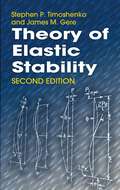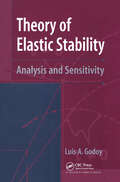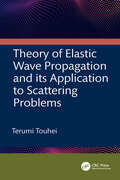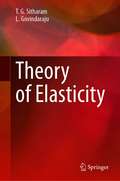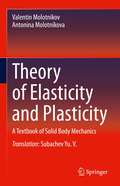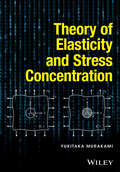- Table View
- List View
Theory and Synthesis of Linear Passive Time-Invariant Networks
by Dante C. YoulaExploring the overlap of mathematics and engineering network synthesis, this book presents a rigorous treatment of the key principles underpinning linear lumped passive time-invariant networks. Based around a series of lectures given by the author, this thoughtfully written book draws on his wide experience in the field, carefully revealing the essential mathematical structure of network synthesis problems. Topics covered include passive n-ports, broadband matching, the design of passive multiplexes and two-state passive devices. It also includes material not usually found in existing texts, such as the theoretical behavior of transverse electromagnetic (TEM) coupled transmission lines. Introducing fundamental principles in a formal theorem-proof style, illustrated by worked examples, this book is an invaluable resource for graduate students studying linear networks and circuit design, academic researchers, and professional circuit engineers.
Theory and Technology of Drilling Engineering
by Zhichuan Guan Tinggen Chen Hualin LiaoThis book presents the theory and technologies of drilling operations. It covers the gamut of formulas and calculations for petroleum engineers that have been compiled over several years. Some of these formulas and calculations have been used for decades, while others help guide engineers through some of the industry’s more recent technological breakthroughs. Comprehensively discussing all aspects of drilling technologies, and providing abundant figures, illustrations and tables, examples and exercises to facilitate the learning process, it is a valuable resource for students, scholars and engineers in the field of petroleum engineering.
Theory and Technology of Laser Imaging Based Target Detection
by Yihua HuThis book systematically introduces readers to laser imaging target detection principles and techniques. It covers the fundamentals of laser imaging and presents an extensive, up-to-date analysis of how to best use laser imaging to detect targets. This is followed by a comprehensive discussion of laser imaging target detection principles, laser imaging generation, and target detection methods. The book offers an invaluable resource for researchers, especially those who are engaged in the fields including target detection based on a laser imaging system, target detection and identification, remote sensing imaging and image processing. Additionally, it can be used as a reference book for advanced undergraduates and postgraduates of relevant majors.
Theory and Technology of Rock Excavation for Civil Engineering
by Dingxiang ZouThis book summarizes the technical advances in recent decades and the various theories on rock excavation raised by scholars from different countries, including China and Russia. It not only focuses on rock blasting but also illustrates a number of non-blasting methods, such as mechanical excavation in detail. The book consists of 3 parts: Basic Knowledge, Surface Excavation and Underground Excavation. It presents a variety of technical methods and data from diverse sources in the book, making it a valuable theoretical and practical reference resource for engineers, researchers and postgraduates alike.
Theory and Technology of Roll Stamping
by Vyacheslav Aleksandrovich Golenkov Sergey Yuryevich Radchenko Daniil Olegovich DorokhovThis book gives a complete overview of the roll stamping process of metal forming. This fundamentally new technique features an integrated local loading of the plastic deformation zone of the workpiece, simultaneously combining the die forging operation and local deformation of the deformation zone by rotating rollers or drive rolls. The book presents the basics of the theory behind roll stamping, delivering a complete technical analysis including the key results of mathematical modeling studies and a discussion of methodologies for designing novel roll stamping techniques. The aim of the new metal forming processes proposed in the book is directed toward the production of competitive equipment for fabrication of various mechanical parts having enhanced materials and physical properties in combination with a low cost of production and maintenance. This book is an ideal resource for any student or practicing engineer working with the roll stamping process.
Theory and Technology of Sheet Rolling: Numerical Analysis and Applications
by V.L. Mazur O. V. NogovitsynDespite significant advances in technology and equipment for rolled steel, the computerization of production processes and the steady increase in production of sheet steel, recent scientific and technological achievements have not been compiled in the special literature and revealed to a wide range of specialists. This book details new approaches, computational techniques, and reliable calculation methods of leaf-rolling modes, forecasting and optimization of the technologies, increasing productivity of the mill and a radical improvement in the quality of steel products.
Theory of Elasticity
by Aldo MaceriThe Theory of Elasticity moves freely within a unified mathematical framework that provides the analytical tools for calculating stresses and deformations in a strained elastic body. All the elastic problems can be exactly analyzed employing the classical Mathematical analysis, with only the exception of the unilateral problems for which it is mandatory to use the Functional analysis. This book focuses on the practical application of the theoretical results. It gives to engineers, in a simple form, a clear indication of the necessary fundamental knowledge of the Theory of elasticity. The author develops the subjects in a classical way, but in light of the modern Mathematical theory of the elasticity and with more accented relief to the connections with the Thermodynamics. To give a clear justification of the fundamental equations of thermoelasticity, he applies a technique of analysis proper of the Fluid dynamics. However in the discussion of the unilateral problems, where the Functional analysis is compulsory, he has related in detail the mathematical aspects of the theoretical analysis.
Theory of Adaptive Structures: Incorporating Intelligence into Engineered Products
by Senol UtkuTheory of Adaptive Structures provides the basic theory for controlling adaptive structures in static and dynamic environments. It synthesizes well-established theories on modern control as well as statics and dynamics of deformable bodies. Discussions concentrate on the discrete parameter adaptive structures dealing with actuator placement, actuator selection, and actuation computation problems - keeping these structures at close proximity of any chosen nominal state with the least energy consumption. An introduction to the distributed parameter adaptive structures is also provided.The book follows that modern trend in research and industry striving to incorporate intelligence into engineered products through microprocessors that are becoming smaller, faster, and cheaper at astounding rates. Not using them in engineered products may become an enormous liability.Resulting from the advances in materials technology on sensors and actuator technologies as well as the availability of very powerful and reliable microprocessors, there is an ever-increasing interest in actively controlling the behavior of engineering systems. Engineers and engineering scientists must revive and broaden their activities to maximize applications for predicting and controlling the behavior of deformable bodies. Topics include:An introduction to adaptive structuresIncremental excitation-response relations in static and dynamic casesActive control of response in static caseStatically determinate adaptive structuresStatically indeterminate adaptive structuresActive vibration control for autonomous and non-autonomous casesActive control against windActive control against seismic loadsDistributed parameter adaptive structuresThe technology of adaptive structures has created an environment where the analysis, not the computation, of structural response - du
Theory of Affine Projection Algorithms for Adaptive Filtering
by Kazuhiko OzekiThis book focuses on theoretical aspects of the affine projection algorithm (APA) for adaptive filtering. The APA is a natural generalization of the classical, normalized least-mean-squares (NLMS) algorithm. The book first explains how the APA evolved from the NLMS algorithm, where an affine projection view is emphasized. By looking at those adaptation algorithms from such a geometrical point of view, we can find many of the important properties of the APA, e. g. , the improvement of the convergence rate over the NLMS algorithm especially for correlated input signals. After the birth of the APA in the mid-1980s, similar algorithms were put forward by other researchers independently from different perspectives. This book shows that they are variants of the APA, forming a family of APAs. Then it surveys research on the convergence behavior of the APA, where statistical analyses play important roles. It also reviews developments of techniques to reduce the computational complexity of the APA, which are important for real-time processing. It covers a recent study on the kernel APA, which extends the APA so that it is applicable to identification of not only linear systems but also nonlinear systems. The last chapter gives an overview of current topics on variable parameter APAs. The book is self-contained, and is suitable for graduate students and researchers who are interested in advanced theory of adaptive filtering.
Theory of Applied Robotics: Kinematics, Dynamics, and Control
by Reza N. JazarTheory of Applied Robotics: Kinematics, Dynamics, and Control presents detailed robotics concepts at a theoretical-practical level, concentrating on their practical use. Related theorems and formal proofs are provided, as are real-life applications. This new edition is completely revised, and includes updated and expanded example sets and problems and new materials. This textbook is designed for undergraduate or first-year graduate programs in mechanical, systems, and industrial engineering. Practicing engineers, researchers, and related professionals will appreciate the book’s user-friendly presentation of a wealth of robotics topics, most notably in 3D kinematics and dynamics of manipulator robots.
Theory of Arched Structures
by Igor A KarnovskyTheory of Arched Structures: Strength, Stability, Vibration presents detailed procedures for analytical analysis of the strength, stability, and vibration of arched structures of different types, using exact analytical methods of classical structural analysis. The material discussed is divided into four parts. Part I covers stress and strain with a particular emphasis on analysis; Part II discusses stability and gives an in-depth analysis of elastic stability of arches and the role that matrix methods play in the stability of the arches; Part III presents a comprehensive tutorial on dynamics and free vibration of arches, and forced vibration of arches; and Part IV offers a section on special topics which contains a unique discussion of plastic analysis of arches and the optimal design of arches..
Theory of Bilayer Graphene Spectroscopy
by Marcin Mucha-KruczyńskiThis thesis presents the theory of three key elements of optical spectroscopy of the electronic excitations in bilayer graphene: angle-resolved photoemission spectroscopy (ARPES), visible range Raman spectroscopy, and far-infrared (FIR) magneto-spectroscopy. Bilayer graphene (BLG) is an atomic two-dimensional crystal consisting of two honeycomb monolayers of carbon, arranged according to Bernal stacking. The unperturbed BLG has a unique band structure, which features chiral states of electrons with a characteristic Berry phase of 2$\pi$, and it has versatile properties which can be controlled by an externally applied transverse electric field and strain. It is shown in this work how ARPES of BLG can be used to obtain direct information about the chirality of electron states in the crystal. The author goes on to describe the influence of the interlayer asymmetry, which opens a gap in BLG, on ARPES and on FIR spectra in a strong magnetic field. Finally, he presents a comprehensive theory of inelastic Raman scattering resulting in the electron-hole excitations in bilayer graphene, at zero and quantizing magnetic fields. This predicts their polarization properties and peculiar selection rules in terms of the inter-Landau-level transitions.
Theory of Charge Transport in Carbon Electronic Materials
by Zhigang Shuai Linjun Wang Chenchen SongMechanism of charge transport in organic solids has been an issue of intensive interests and debates for over 50 years, not only because of the applications in printing electronics, but also because of the great challenges in understanding the electronic processes in complex systems. With the fast developments of both electronic structure theory and the computational technology, the dream of predicting the charge mobility is now gradually becoming a reality. This volume describes recent progresses in Prof. Shuai's group in developing computational tools to assess the intrinsic carrier mobility for organic and carbon materials at the first-principles level. According to the electron-phonon coupling strength, the charge transport mechanism is classified into three different categories, namely, the localized hopping model, the extended band model, and the polaron model. For each of them, a corresponding theoretical approach is developed and implemented into typical examples.
Theory of Concrete-Filled Steel Tubular Structures
by Lin-Hai HanThis textbook focuses on concrete-filled steel tubular structures formed by placing concrete inside the steel tube. It deals with the mechanical essence of concrete-filled steel tubular members in compression/tension, bending, torsion, shear and the combined effects, the working mechanism of concrete-filled steel tubular members under long-term load, cyclic load, fire exposure and post-fire exposure, and proposes practical design methods based on experimental and theoretical studies and parametric analysis. The content addresses some key technical issues of concrete-filled steel tubular members, such as the mechanical properties of steel and core concrete, the shrinkage and creep of core concrete, the bonding behavior between steel tube and core concrete, the limiting values for the initial stress of steel tube caused by construction load and the void of core concrete, the protective design of concrete-filled steel tubular members under chloride corrosive environment and impact loading, etc. This textbook also discusses the technology and design principles of concrete-filled steel tubular hybrid structures.
Theory of Cryptography: 16th International Conference, TCC 2018, Panaji, India, November 11–14, 2018, Proceedings, Part II (Lecture Notes in Computer Science #11240)
by Amos Beimel Stefan DziembowskiThe two-volume set of LNCS 11239 and LNCS 11240 constitutes the revised proceedings of the 16th International Conference on Theory of Cryptography, TCC 2018, held in Panaji, India, in November 2018.The total of 50 revised full papers presented in the proceedings were carefully reviewed and selected from 168 submissions. The Theory of Cryptography Conference deals with the paradigms, approaches, and techniques used to conceptualize natural cryptographic problems and provide algorithmic solutions to them and much more.
Theory of Cryptography: 16th International Conference, Tcc 2018, Panaji, India, November 11-14, 2018, Proceedings, Part Ii (Lecture Notes in Computer Science #11240)
by Amos Beimel Stefan DziembowskiThe two-volume set of LNCS 11239 and LNCS 11240 constitutes the revised proceedings of the 16th International Conference on Theory of Cryptography, TCC 2018, held in Panaji, India, in November 2018.The total of 50 revised full papers presented in the proceedings were carefully reviewed and selected from 168 submissions. The Theory of Cryptography Conference deals with the paradigms, approaches, and techniques used to conceptualize natural cryptographic problems and provide algorithmic solutions to them and much more.
Theory of Differential Equations in Engineering and Mechanics
by Kam Tim ChauThis gives comprehensive coverage of the essential differential equations students they are likely to encounter in solving engineering and mechanics problems across the field -- alongside a more advance volume on applications. This first volume covers a very broad range of theories related to solving differential equations, mathematical preliminaries, ODE (n-th order and system of 1st order ODE in matrix form), PDE (1st order, 2nd, and higher order including wave, diffusion, potential, biharmonic equations and more). Plus more advanced topics such as Green’s function method, integral and integro-differential equations, asymptotic expansion and perturbation, calculus of variations, variational and related methods, finite difference and numerical methods. All readers who are concerned with and interested in engineering mechanics problems, climate change, and nanotechnology will find topics covered in these books providing valuable information and mathematics background for their multi-disciplinary research and education.
Theory of Digital Automata
by Oleksandr Petrov Mykola Karpinskyy Bohdan Borowik Valery LahnoThis book serves a dual purpose: firstly to combine the treatment of circuits and digital electronics, and secondly, to establish a strong connection with the contemporary world of digital systems. The need for this approach arises from the observation that introducing digital electronics through a course in traditional circuit analysis is fast becoming obsolete. Our world has gone digital. Automata theory helps with the design of digital circuits such as parts of computers, telephone systems and control systems. A complete perspective is emphasized, because even the most elegant computer architecture will not function without adequate supporting circuits. The focus is on explaining the real-world implementation of complete digital systems. In doing so, the reader is prepared to immediately begin design and implementation work. This work serves as a bridge to take readers from the theoretical world to the everyday design world where solutions must be complete to be successful.
Theory of Disordered Solids: From Atomistic Dynamics to Mechanical, Vibrational, and Thermal Properties (Lecture Notes in Physics #1015)
by Alessio ZacconeThis book presents a consistent mathematical theory of the non-electronic physical properties of disordered and amorphous solids, starting from the atomic-level dynamics and leading to experimentally verifiable descriptions of macroscopic properties such as elastic and viscoelastic moduli, plasticity, phonons and vibrational spectra, and thermal properties. This theory begins with the assumption of the undeniable existence of an “amorphous lattice”, which allows one to relegate the theoretical uncertainties about the ultimate nature of the glass transition to a subsidiary role and thus take a more pragmatic approach towards the modelling of physical properties. The book introduces the reader not only to the subtle physical concepts underlying the dynamics, mechanics, and statistical physics of glasses and amorphous solids, but also to the essential mathematical and numerical methods that cannot be readily gleaned from specialized literature since they are spread out among many often technically demanding papers. These methods are presented in this book in such a way as to be sufficiently general, allowing for the mathematical or numerical description of novel physical phenomena observed in many different types of amorphous solids (including soft and granular systems), regardless of the atomistic details and particular chemistry of the material. This monograph is aimed at researchers and graduate-level students in physics, materials science, physical chemistry and engineering working in the areas of amorphous materials, soft matter and granular systems, statistical physics, continuum mechanics, plasticity, and solid mechanics. It is also particularly well suited to those working on molecular dynamics simulations, molecular coarse-grained simulations, as well as ab initio atomistic and DFT methods for solid-state and materials science.
Theory of Elastic Stability
by Stephen P. Timoshenko James M. GereThe best available guide to the elastic stability of large structures, this book introduces the principles and theory of structural stability. It was co-authored by the father of modern engineering mechanics, Stephen Timoshenko, and James Gere, who updated the materials and worked closely with Dr. Timoshenko. Relevant to aspects of civil, mechanical, and aerospace engineering, this classic covers the essentials of static and dynamic instabilities.Topics range from theoretical explanations of 2- and 3-D stress and strain to practical applications such as torsion, bending, thermal stress, and wave propagation through solids. Additional subjects include beam columns, curved bars and arches, buckling of rings, and experiments and design formulas. Particularly suitable for advanced undergraduate and graduate students of engineering, this volume is also an indispensable reference for professionals.
Theory of Elastic Stability: Analysis and Sensitivity
by Luis A. GodoyThis book gives a unified presentation of the field of stability. Buckling and post-buckling states are studied on the basis of total potential energy of structural systems. Emphasis is placed throughout the text on post-buckling analysis and behaviour. The sensitivity of buckling and post-buckling states to changes in design parameters is also discussed as well as changes due to imperfections and damage.
Theory of Elastic Wave Propagation and its Application to Scattering Problems
by Terumi TouheiElastic wave propagation applies to a wide variety of fields, including seismology, non-destructive testing, energy resource exploration, and site characterization. New applications for elastic waves are still being discovered. Theory of Elastic Wave Propagation and its Application to Scattering Problems starts from the standpoint of continuum mechanics, explaining stress and strain tensors in terms of mathematics and physics, and showing the derivation of equations for elastic wave motions, to give readers a stronger foundation. It emphasizes the importance of Green’s function for applications of the elastic wave equation to practical engineering problems and covers elastic wave propagation in a half-space, in addition to the spectral representation of Green’s function. Finally, the MUSIC algorithm is used to address inverse scattering problems. Offers comprehensive coverage of fundamental concepts through to contemporary applications of elastic wave propagation Bridges the gap between theoretical principles and practical engineering solutions The book’s website provides the author’s software for analyzing elastic wave propagations, along with detailed answers to the problems presented, to suit graduate students across engineering and applied mathematics.
Theory of Elasticity
by T. G. Sitharam L. GovindarajuTheory of Elasticity provides a modern and integrated treatment of the foundations of solid mechanics as applied to the mathematical description of material behavior primarily to serve the needs of undergraduate, postgraduate and research students of Civil, Mechanical and Aeronautical engineering. Basic concepts, definitions, theory as well as related practical applications are discussed in a logical and concise manner. The book includes a pedagogical features such as worked examples and problems to consolidate the readers’ understanding of fundamental principles and illustrates their applications in many practical situations. An important feature of this book lies in the use of linear theory of elasticity to obtain solutions to some of the specialized problems related to soil mechanics and foundation engineering in particular.
Theory of Elasticity and Plasticity: A Textbook of Solid Body Mechanics
by Valentin Molotnikov Antonina MolotnikovaThis book serves as a core text for university curricula in solid body mechanics and, at the same time, examines the main achievements of state of the art research in the mechanics of elastic and non-elastic materials. This latter goal of the book is achieved through rich bibliographic references, many from the authors’ own work. authors. Distinct from similar texts, there are no claims in this volume to a single universal theory of plasticity. However, solutions are given to some new problems and to the construction of models useful both in pedagogic terms for students and practical terms for professional design engineers. Examples include the authors’ decisions about the Brazilian test, stability of rock exposure, and pile foundations. Designed for both upper-level university students and specialists in the mechanics of deformable hard body, the material in this book serves as a source for numerous topics of course and diploma concentration.
Theory of Elasticity and Stress Concentration
by Yukitaka MurakamiTheory of Elasticity and Stress Concentration Yukitaka Murakami, Kyushu University, Japan A comprehensive guide to elasticity and stress concentration Theory of Elasticity and Stress Concentration comprehensively covers elasticity and stress concentration and demonstrates how to apply the theory to practical engineering problems. The book presents a new approach to the topic without the need for complicated mathematics, and the principles and meaning of stress concentration are covered without reliance on numerical analysis. The book consists of two parts: Part I - Theory of Elasticity and Part II - Stress Concentration. Part I treats the theory of elasticity from the viewpoint of helping the reader to comprehend the essence of it. Part II treats the principle and meaning of stress concentration and guides the reader to a better understanding of it. Throughout the book, many useful and interesting applications of the basic new way of thinking are presented and explained. Key features: Unique approach to the topics. Encourages the readers to acquire the new way of thinking and engineering judgement. Includes examples, problems and solutions. This book provides essential reading for researchers and practitioners in the structural and mechanical engineering industries.

